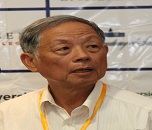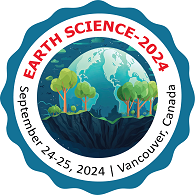Renowned Speakers

Jerzy Judyn
University of Toronto Canada, Canada Canada

Liming Zhou
State University of Newyork USA USA

Joseph Tomain
University of Cincinnati USA USA

Nicola Scafetta
University of Napies Federico Italy Italy

Li Wei
Taiyuan University of Technology, China China

Mitsuru Osaki
Hokkaido University Japan Japan

Moktar Hamdi
University of Carthage Tunisia Tunisia

Nai Kuang Liang
International Ocean & Atmosphere Research Foundation Taiwan Taiwan
Recommended Global Geology & Earth Science Webinars & Conferences
Europe & UK
Asia Pacific & Middle East
Canada
Earth science-2024
About Conference
The Organizing Committee Members are pleased to invite you to the 5th Global Summit on Earth Science and Climate Change 2024, which will be held from September 24-25, 2024 Vancouver, Canada. The theme of the conference is "Sustainable Energy for a Greener Future."
The 5th Global Summit on Earth Science and Climate Change 2024 (Earth Science 2024) aims to bring together researchers, scholars, scientists, policymakers, industry experts, biomedical specialists, environmentalists, academics, and meteorologists on one platform to showcase their research efforts. We invite participants from around the world to attend Earth Science 2024 for an enriching experience, networking opportunities, publishing, and much more.
The primary objective of the 5th International Summit on Earth Science and Climate Change is to strengthen the global response to the challenges of climate change and global warming, and to put the Earth on a safer and more sustainable development path. Earth Science 2024 provides a great platform for developing nations to learn from advanced nations in overcoming their challenges in reducing global warming. Meanwhile, advanced nations can also benefit from sharing knowledge to maintain a healthy climate.
Earth Science 2024 is a comprehensive international conference on all aspects of global warming, including its causes, impacts, and potential outcomes. This conference aims to provide a forum for the exchange of specialized information, dissemination of high-quality research results, contribution of new policies and scientific developments, and promotion of future priorities for sustainable development and energy security. Participants from all disciplines related to global warming (e.g., ecology, education, engineering, natural sciences, social sciences, economics, operations, physical sciences, information technology, etc.) are invited to contribute to this unique event.
Why to Attend
Earth Science 2024 is set to welcome hundreds of delegates, featuring renowned transnational keynote speakers and scholars delivering oral presentations and bill donations. Exhibitions and delegates from all corners of the globe will come together to establish a platform for global innovation and impactful advancements in this field. The event offers unparalleled opportunities for transnational networking and collaborations with international companies, all while addressing the pressing issue of global warming.
This prestigious congress will serve as a remarkable gathering for Global Warming Scientists and other professionals. With an expected attendance of approximately 100 speakers and over 200 delegates, this event promises to be a truly exceptional occasion.
Target Audience
- Academies
- Researchers
- Diligence
- Scholars
- Ecologists
- Meteorologists
- Marine biologists
- Oceanographers
- Environmental experimenters
- Business entrepreneurs
- Training institutes
- Microbiologists
- Chemical/biological masterminds
- Biochemistry experimenters
- Environmental masterminds
- Waste operation associations
- Environmental and Climate Change Policy Judges
Major Earth Science and Climate Change Related Associations around the Globe
Earth System Governance Project (ESGP)
Global Environment Facility (GEF)
Intergovernmental Panel on Climate Change (IPCC)
International Union for Conservation of Nature (IUCN)
United Nations Environment Programme (UNEP)
World Nature Organization (WNO)
Earth Charter Initiative
Earth Day Network
Green Actors of West Africa (GAWA)
Interamerican Association for Environmental Defence
International Network for Sustainable Energy
List of environmental and conservation associations in the United States
Sessions and Tracks
Track 1: Soil Science
The worldwide agrochemical show was valued at $197.9 billion in 2014. This request is needed to reach nearly $207.9 billion out of 2015 and $257.5 billion out of 2019, prior to expanding at an emulsion monthly development rate (CAGR) of 5.4 from 2014 to 2019.
- Soil Fertility and Soil Biochemistry Experts Meeting
- Soil corrosion and soil operation
- Sustainable Soils and Soil Geology
- Soil Morphology
Track 2: Hydrology and Water Resources
Hydrology is the logical disquisition of the development, appropriation, and nature of water on Earth and different globes, including the water cycle, water means, and ecological watershed manageability. A specialist in hydrology is a hydrologist, working in the fields of earth or ecological wisdom, physical geomorphology, terrain, and common and natural engineering. Using different individual strategies and logical procedures, they gather and probe information to help attack water-related issues, for example, ecological conservation, disastrous events, and water administration. Hydrology subdivides into face water hydrology, groundwater hydrology (hydrogeology), and marine hydrology. Areas of hydrology incorporate hydrometeorology, face hydrology, hydrogeology, seepage coliseum administration, and water quality, where water assumes the focal part. Oceanography and meteorology are barred in light of the fact that water is just one of the many multitudinous critical angles inside those fields.
Track 3: Oceanography and Marine Biology
Oceanology is the branch of geography that studies the ocean. It covers an expansive variety of subjects, including natural system rudiments; ocean aqueducts, swells, and geophysical liquid progression; plate tectonics and the geomorphology of the ocean bottom; and fluxes of different synthetic substances and physical parcels inside the ocean and over its limits. These varied subjects depict different controls that oceanographers mix to further information about the World Sea and appreciation of procedures inside space wisdom, wisdom, wisdom, climatology, geomorphology, terrain, hydrology, meteorology, and material wisdom. Pale oceanography concentrates on the literal background of the swell in geologic history. Branches are of four kinds: biological oceanography, chemical oceanography, geological oceanography, and physical oceanography.
- Abysses and Climate Change
- Marine Data Management
- Marine Engineering and Technology
- Coastal Oceanography
- Abysses and climate change
Track 4: Climate Change Mitigation
Financial instruments can be precious in planning environmental change temperance strategies." "While the impediments of fiscal matters and social welfare examination, including cost-advantage disquisition, are generally reported, fiscal matters all effects considered give helpful bias to assessing the trends and downsides of taking, or not taking, exertion on environmental change relief, just as adaptation measures, in negotiating contending societal objects. Understanding these trends and downsides can help in settling on arrangement choices on environmental change relief and can impact the moves made by nations, foundations, and people."
A compass of vital inventions may contribute to environmental change mitigation. These incorporate infinitesimal power and sustainable power sources, for example, biomass, hydroelectricity, wind control, sun-grounded power, geothermal power, ocean vitality, and the application of carbon cesspools and carbon catch and capacity.
- The rise and fall of societies
- Working on their own climate problems
- Mortal hindrance to the climate system
- The thing about mitigation
Track 5: Marine Geosciences
Marine earth wisdom, or geological oceanography, is the study of the history and structure of the ocean bottom. It involves geology, geochemistry, sedimentological, and paleontological examinations of the ocean bottom and littoral zone. Marine earth wisdom has robust ties to geology and to physical earth wisdom. Marine matter surroundings are centered on palaeontology, geobiology, pale-oceanography and archaeology, organic and inorganic snippet biogeochemistry, marine minerals, carbonate sedimentology, and thus the physical parcels of sediments and crustal jewels. More than half of our nation's population lives among the fifty long hauls of the seacoast. Healthy littoral and coastal conservation areas are veritably important to our nation's frugality. The USGS studies littoral revision, hazards that impact littoral areas, ocean coffers, and littoral and marine ecosystems.
- Marine lore’s
- Frugality and legislation in marine
- Marine terrain
- Coastal structures
Track 6: Soil Pollution
Soil pollution or soil impurity, as a major aspect of land debasement, is brought on by the presence of xenobiotic, i.e., mortal-made chemicals, or other changes in the regular soil terrain. It's naturally created by ultramodern action, pastoral chemicals, or the uncalled-for transfer of waste. The most extensively honoured chemicals included are petroleum hydrocarbons, polynuclear ambrosial hydrocarbons, detergents, fungicides, inviting essences like cadmium, chromium, and lead, some inorganic acids, and radioactive substances like radionuclides. Impurity corresponds with the position of industrialization and the force of substance use. The solicitude over soil pollution stems basically from health troubles, direct contact with the demoralized soil, vapours from the pollutants, and voluntary tarnishing of water inventories outside and hiding the dirt. Mapping of bemired soil locales and the posterior clean-up are tedious and expensive errands, taking broad measures of geomorphology, hydrology, and wisdom, PC displaying aptitudes, and Civilians in Environmental Contamination, and also a valuation for the literal background of ultramodern wisdom.
Track 7: Earth Science
Earth wisdom, or geoscience, includes all fields of wisdom associated with the world. This is frequently a branch of wisdom managing the physical constitution of the world and its atmosphere. Earth wisdom is the study of our earth’s physical characteristics, from earthquakes to drops and cataracts to fuds. The multitudinous purpose of the world's lore is to admit the present capabilities and thus the once-elaboration of the world and to use this information, whereby respectable, for the advantage of the mortal race. Some earth scientists use their knowledge of the world to find and develop energy and natural resources. Others study the impact of human action on Earth's terrain and style ways to cover the world.
- Earth's Plates software
- Environmental Geo-Wisdom
- Glossary of geology terms
- Structure of the Earth
- GEO-LEO ( GEO Library Experts Online)
Track 8: Climate Change
Climate change, also called global warming, refers to the rise in average surface temperatures on Earth. Climatology, the wisdom of climate and its relation to factory and beast life, is important in numerous fields, including husbandry, aeronautics, drugs, botany, zoology, geology, and terrain. Changes in climate affect, for example, the factory and beast life of a given area. Climatology, the wisdom of climate and its relation to factory and beast life, is important in numerous fields, including husbandry, aeronautics, drugs, botany, zoology, geology, and terrain. Changes in climate affect, for example, the factory and beast life of a given area.
- Climate Change and Climatology
- CO2 Responsible Climate Change
- Sustainability and climate change
- Climate Change Law and Policy
- Space Monitoring of Climate Variables
- Climate change economics
- Climate Change Challenges
- Effective Adaption
- Pitfalls of climate change
- Climate Hazards
- CO2 capture and sequestration
- Carbon Cycle
- Climate change and health
- Climate Change Biodiversity scripts
- Substantiation of climate change
- Results for Climate Change
Track 9: Atmospheric Chemistry
The chemical composition of the atmosphere has been changing rapidly over the last several decades. Global change exploration has been successful in developing a scientific understanding of several of these changes, such as stratospheric ozone reduction. The assessment and understanding of other problems such as tropospheric ozone and aerosols and their places in climate and chemical processes remain largely shy.
- Oxygen cycle
- Ozone-oxygen cycle
- Paleoclimatology
- Scientific Assessment of Ozone Reduction
- Tropospheric ozone reduction events
Track 10: Pollution Control
Pollution is the presence of a contaminant in the terrain and is frequently the result of human conduct. Pollution has a mischievous effect on the terrain. Creatures, fish, and other submarine life, shops, and humans all suffer when pollution isn't controlled. In other words, pollution is the introduction of pollutants into the environment that cause dangerous and poisonous goods to have living effects. Pollution can take the form of chemical substances or energy, such as noise, heat, or light. Pollution is frequently classified as point-source pollution. Noise pollution, soil pollution, and light pollution too are damaging the terrain at an intimidating rate. Effects as simple as light, sound, and temperature can be considered adulterants when introduced instinctively into a terrain. Air pollution is by far the most dangerous form of pollution in our region. Air pollution is caused by the pernicious emissions emitted by buses, motorcars, exchanges, trains, and manufactories, including sulphur dioxide, carbon monoxide, and nitrogen oxides. Poisonous pollution affects more than 200 million people worldwide. In some of the world’s worst-weakened places, babies are born with birth blights, children have lost 30 to 40 Command points, and life expectancy may be as low as 45 times because of cancer and other conditions.
- Pollution and its effects on climate
- Waste water pollution
- Carbon Cycle
- Marine Pollution
- Industrial Pollution
- Pollution Control Technologies and Bias
Track 11: Ecology and Ecosystems
Anticipation of unborn worldwide natural changes requires a logical appraisal of the present state of fleshly and marine natural communities and an appreciation of extensive-scale terrestrial and marine environmental procedures. Integrative earth frame models are imperative instruments for accommodating and requesting this environmental data.
Carbon Cycle The carbon cycle is the biogeochemical cycle by which carbon is traded among the biosphere, pedosphere, geosphere, hydrosphere, and air of the Earth. Alongside the nitrogen cycle and the water cycle, the carbon cycle involves a race of occasions that are vital to making the Earth fit for supporting life; it portrays the development of carbon as its reused and reused all through the biosphere, including carbon sinks. The worldwide carbon spending plan is the acclimate of the trades (earnings and mischances) of carbon between the carbon inventories or between one particular circle (e.g., climate<-> biosphere) of the carbon cycle. An examination of the carbon spending plan of a pool or depository can give data about whether the pool or store is working as a source or Gomorrah for carbon dioxide. The carbon cycle was first set up by Joseph Priestley and Antoine Lavoisier and promoted by Humphrey Davy. Carbon-ground tittles are essential for life on Earth since they're the principle members of organic composites. Carbon is also a noteworthy member of the multitudinous minerals. Carbon also exists in different structures in the terrain. Carbon dioxide (CO2) is half in charge of the nursery impact and is the most vital human-contributed nursery gas.
Track 12: Natural Hazards
It's the wisdom that deals with the origin, elaboration, structure, composition, and geste of Earth's geographies, places, and surroundings. It includes studies assessing environmental studies, spatial studies, and satellite events. It's an applied wisdom concerned with the practical operation of the principles of geology in the solving of environmental problems. It includes hydrogeology, environmental mineralogy, hydro geochemistry, and soil mechanics. The fundamental generalities of environmental geology are: mortal population growth, sustainability, Earth as a system, dangerous earth processes that involve geologic hazards, natural coffers, and topical issues of concern to society, such as climate change, and providing sound advice about how humanity can live responsibly and sustainably on Earth. Environmental geology applies geologic information to the result, valuation, and study of geologic problems similar to earth attributes, natural hazards, landscape evaluation, environmental impact analysis, and remediation. Forces within the Earth produce mountain ranges and ocean basins and drive the movements of mainland’s. Wind, water, and ice shape the face of the earth, making and changing the geographies.
- Intimidating cautions and early warning systems
- Disaster risk management
- Geographic Information
- Ecosystems and biodiversity
- Space Disasters
- Health disasters and pandemics
- Geological disasters and earthquakes
Track 13: Fossil Energies and Energy
Fossil empowers are powers moulded by ordinary systems, for example, the anaerobic decay of secured dead living beings, containing essentialness starting in antiquated photosynthesis. The age of the living effects and their preceding reactionary forces is generally an expansive number of times, and as a lower-than-reliable rule, it outperforms 650 million times. Fossil forces contain high rates of carbon and consolidate oil painting, coal, and trademark gas. Reactionary empowers keep running from temperamental accoutrements with low carbon hydrogen extents like methane, to liquids like oil painting, to non-volatile accoutrements made out of, for all intents and purposes, faultless carbon, as Bacillus anthraces relate to coal. Methane can be set up in hydrocarbon fields either alone, associated with oil painting, or at methane rates. The Energy Information Administration surveys that in 2007, the abecedarian wellsprings of imperativeness included oil painting (36.0), coal (27.3), and introductory gas (24.0), signifying an 86.4 offer for reactionary powers in introductory essentialness use on the earth. Non-fossil sources in 2006 included nuclear 8.5, hydroelectric 6.3, and others (geothermal, sun-powered, tidal, wind, wood, and waste), signifying 0.9. World imperativeness use was getting to be around 2.3 constantly. The proposition that reactionary forces mouldered from the fossilized remains of dead shops by preface to warmth and weight in the Earth's covering over an immense number of times( 5) was at first displayed by Georgius Agricola in 1556 and latterly by Mikhail Lomonosov in the eighteenth century.
Track 14: Renewable Energy and Resources
Renewable energy is gaining significance in today’s world. In addition to the rising costs of fossil energies and the trouble of climate change, there have been a lot of positive developments in this field, including improved energy effectiveness and reduced prices. The sun, geothermal energy, and wind are exemplifications of renewable energy. These energy sources are indefatigable and constantly replenished. Renewable energy plays an important part in reducing greenhouse gas emigrations. Also, the demand for fossil energy goes down when renewable energy products are used.
Track 15: Climate Change and Sustainability
Sustainability can also be defined as a socio-ecological process characterized by the pursuit of a common ideal. An ideal is, by description, unattainable in a given time and space. Still, by persistently and stoutly approaching it, the process results in a sustainable system. The study of ecology believes that sustainability is achieved through the balance of species and the coffers within their terrain.
Track 16: Environmental Engineering
Environmental engineering is a professional engineering discipline that takes from broad scientific motifs like chemistry, biology, ecology, geology, hydraulics, hydrology, microbiology, and mathematics to produce results that will cover and also improve the health of living organisms and ameliorate the quality of the terrain. Environmental engineering is a discipline of civil engineering, chemical engineering, and Mechanical engineering.
Track 17: Agriculture and Food Security
The agriculture conference focuses on the content of food security and welcomes all people who are related to food security. Policy exposures for food security and safety include state-wise, former, current, and unborn policy issues, and cope-wise sustainability of husbandry. The particular part of food distribution in our society can be examined through the exploration of the changes in the food supply chain. Globalization, in particular, has significant effects on the food supply chain by validating scale effects in food distribution assiduity. Provision of an acceptable quantity of essential nutrients to mortal beings has always been the challenge in the field of food security. Hence, malnutrition is heavily connected to food security considerations yet delicate to be excluded. Food security and policy, thus, become glamorous in the fiefdom of exploration.
- Food and nutrition security
- Sustainable intensification of food product systems
- Innovative ways of feeding the population
- Food storehouses and technology
- Fermentation Technology and Cereals
Track 18: Plant Science and Biotechnology
The agriculture conference focuses on the content of factory wisdom and invites all students, scientists, and professors who are related to factory wisdom. Plant science will accelerate the application of gene technology to agriculture. The compass of factory wisdom ranges from developing molecular ways for inheritable engineering to ecological exploration in the field of factory wisdom. Eventually, the natural products want to contribute to an abecedarian knowledge of introductory natural processes related to development and health and the sustainable product of further healthy foods, flowers, and high-value memoir-rooted products. By accelerating the operation of technology, factory genomics significantly increases the value of seeds and agrarian products. This increase adds important wealth to the guests, company possessors, workers, and citizens of the nations in which inheritable force companies operate and to both producing and importing nations whose food costs accordingly are dropped.
Track 19: Green Energy
Green chemistry surfaced from a variety of ideas and exploration sweats (similar to snippet frugality and catalysis) in the period leading up to the 1990s, in the environment of adding attention to problems of chemical pollution and resource reduction. The development of green chemistry in Europe and the United States was linked to a shift in environmental problem-solving strategies—a movement from command and control regulation and the reduction of artificial emigrations at the" end of the pipe" toward the active forestalling of pollution through the innovative design of product technologies themselves.
- For a technology to be considered green chemistry, it must negotiate three effects.
- It must be functionally original to outperform being druthers.
Green Chemistry presents diligence with inconceivable opportunities for growth and competitive advantage. This is because there's presently a significant deficit of green technologies. We estimate that only 10 of the current technologies are environmentally benign; another 25 could be made fairly benign. The remaining 65 have yet to be constructed! Green Chemistry also creates cost savings when dangerous accoutrements and processes are removed. All hazard-related costs are also removed, similar to those associated with running, transportation, disposal, and compliance. Through green chemistry, environmentally benign alternatives to current accoutrements and technologies can be totally introduced across all types of manufacturing to promote a more environmentally and economically sustainable future.
Track 20: Biodiversity Conservation
Biodiversity helps in maintaining climate change and also prevents natural disasters. Biodiversity helps to regulate the nutrient cycle and water (e.g., cataracts) and mitigates the impacts of climate change. In simple terms, it's the variability and variety of living organisms, together with the ecological installations in which they live. Let us try to understand biodiversity as a whole and biodiversity conservation, which has become a major issue in this developing age. This conference will provide a platform to bandy on biodiversity and ecology restoration for the sake of humanity.
Market Analysis
Earth Science is generating energy that produces no greenhouse emissions from fossil fuels and reduces pollution. The renewable energy industry remains one of the most vibrant, fast-changing, and transformative sectors of the global economy. Technological advancements, cost reductions, and the catalytic influence of recent support structures have made the world a magnet for profitable growth in this field. The renewable energy sector specializes in new and sustainable renewable energy technologies. However, investors worldwide have paid less attention to this rising industry in recent times.
The global demand for renewable energy is expected to grow significantly in the forecast period due to increased emissions of greenhouse gases (GHGs), particularly from the use of fossil fuels for energy generation. Additionally, the finite availability of fossil fuels and their unpredictable prices drive the demand for renewable energy. However, the generation of energy from renewable sources requires substantial investment, which is expected to hinder demand growth in the forecast period. Furthermore, in the Middle East, fossil fuels are primarily used for energy production due to their cost-effectiveness compared to other regions, which hampers the expansion of renewable energy demand. Despite these challenges, the renewable energy demand is projected to reach high levels by 2025.
The global renewable energy demand was valued at $928.0 billion in 2019 and is expected to reach $billion by 2025, registering a CAGR of 6.1% from 2015 to 2025.
To Collaborate Scientific Professionals around the World
Conference Date September 24-25, 2024
For Sponsors & Exhibitors
Speaker Opportunity
Useful Links
Past Conference Report
Supported By
All accepted abstracts will be published in respective Conference Series International Journals.
Abstracts will be provided with Digital Object Identifier by



